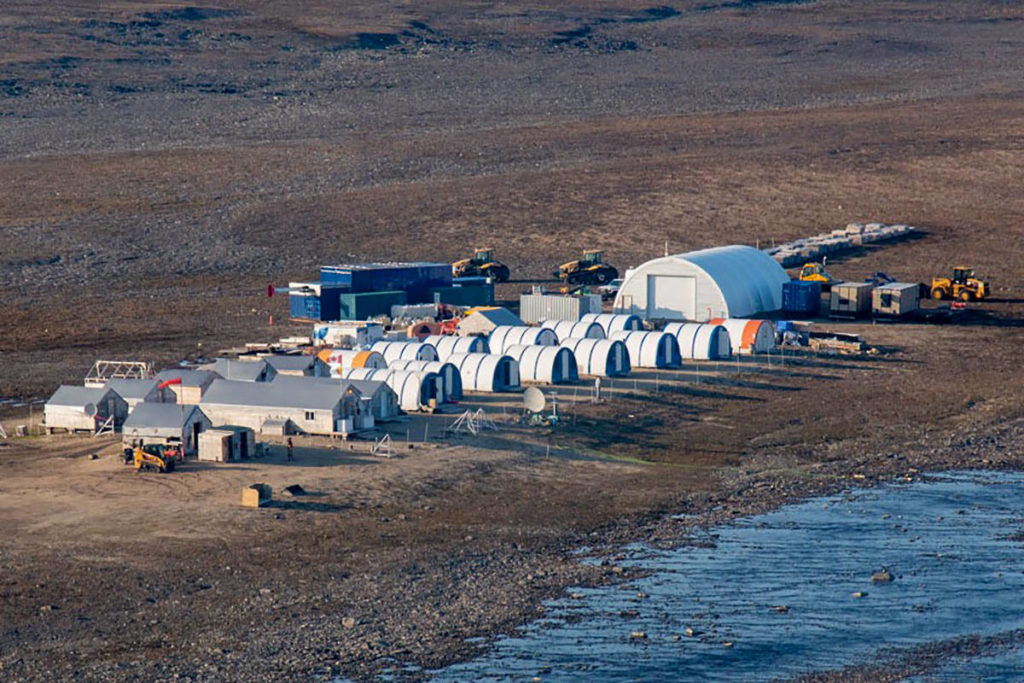De Beers considers carbon-neutral diamond mine near Iqaluit

An aerial view of Discovery Camp at the Chidliak diamond project, approximately 120 kilometres northeast of Iqaluit. photo courtesy of De Beers
De Beers has set an ambitious goal to make the Chidliak Project its first carbon neutral diamond mine.
Consequently, the company is looking to build a low-impact operation using renewable energy and cutting-edge technology.
The project is located on the Hall Peninsula of Baffin Island, approximately 200 kilometres south of Pangnirtung and about 120 kilometres from Iqaluit.
Due to the large number of kimberlite pipes – carrot-shaped geologic formations that often contain diamonds – De Beers is looking to design the operation using high-tech mining techniques, according to De Beers spokesperson Terry Kruger.
Some of these technologies include modular buildings that could easily be moved from place to place, precision mining techniques, virtual technologies and renewable energy.
The company is also considering “heavy lift cargo airships,” stated Kruger, which means De Beers might be planning to operate the mine without building an expensive road to the remote region and would instead rely on air transport.
But there’s still a lot of work to be done.
“At this time there is no timeline to advance permitting or commence mining until the right mix of sustainable technologies can be engineered,” stated Kruger.
Exploration work has identified 74 kimberlite pipes at the site, of which 41 could be gem-producing. De Beers Canada acquired the project from Peregrine Diamonds in September 2018.
The main deposit, named CH-6, contains about 18 million carats in around 7.5 million tonnes of kimberlite. A smaller pipe, CH-7, is estimated to contain roughly 4.2 million carats in about 5.0 million tonnes of kimberlite.
When asked if there have been any further talks with the City of Iqaluit and the Qikiqtani Inuit Association about the possibility of collaborating on a joint renewable energy project that would power the mine and the city, Kruger stated “We look forward to continuing to build relationships with the Hamlet of Pangnirtung, City of Iqaluit, the Government of Nunavut, the QIA and numerous other stakeholders in order to identify opportunities for regional collaborative development.”
“We recognize that De Beers has a responsibility to help diversify the economies of local communities so that they are sustainable long after we have recovered our last diamond,” he continued.
Qikiqtani Inuit Association president P.J. Akeeagok said his organization is “open in terms of any mine within the Qikiqtani region,” but there are terms and conditions to be met.
“Obviously it’s a prospective project (Chidliak) at this point,” said Akeeagok. “I think it’s very clear from this (Baffinland Iron Mines’ Mary River Mine expansion) experience so far that Inuit must be at the forefront right from the very beginning. That’s something that we heard from Inuit, from the communities, in terms of respect of Inuit qaujimajatuqangit and allowing Inuit to be (involved in) the decision-making right from the beginning.”
A spokesperson for Iqaluit Mayor Kenny Bell stated, “Mayor Bell does not have much knowledge about this project as it does not involve the City of Iqaluit in the decision-making.”
In 2019, De Beers conducted several environmental baseline studies and a small geotechnical drill program on the CH-6 kimberlite from the project’s base camp.
However, as with most northern enterprises, the Chidliak project has been impacted by the Covid-19 pandemic, and most field work and community engagement activities, including work on a traditional knowledge study, were suspended in 2020, according to Kruger.
Instead, the company focused on research and design, including the development of satellite-based systems that could provide critical data on vegetation, terrain and wildlife.
“This technology is advancing rapidly and will soon be an indispensable technique for environmental and ecological monitoring,” he stated.
A four-day maintenance trip to inspect the property and look after field sensors was conducted in May 2020 with the help of Iqaluit-based commercial drone company Arctic UAV.
This year, work will centre on environmental studies that will include travelling to the site in the early summer and early fall, he stated.
The focus will be on maintaining field sensors and the base camp, in addition to water studies.
“No geological work is planned at this time,” he stated. “Additionally, we are working to restart working groups in Iqaluit and Pangnirtung to advance the traditional knowledge study. De Beers’ Diamond FutureSmart technical team will also continue its desktop studies.”
This article first appeared on Nunavut News.